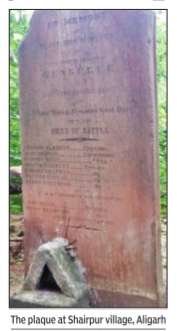Shairpur
This is a collection of articles archived for the excellence of their content. |
Villagers worship British solders
The Times of India, Aug 10 2015

Arvind Chauhan
In a strange twist of fate, nine British soldiers who died fighting rebels in the 1857 freedom struggle near this village are now worshipped by the villagers. The locals, who believe the souls of the nine soldiers protect them from evil spirits, have turned the memorial plaque into a shrine. Nearly 121 km from Agra, in the Gangiri block of Aligarh district on its border with Kasganj, the plaque at Shairpur village commemorates British cavalrymen from two highly decorated regiments -the 6th Dragoon Guards, also known as the Carabiniers, and the 9th Queen's Royal Lancers, who for their participation in the events of 1857 came to be called the Del hi Spearmen. The structure, known locally as `Kalajar' since the war was fought near the Kaali river, has shrunk to its current size of 20 sq ft after villagers took up the surrounding land for cultivation.
However, what remains is of occult significance for locals. “On every holy occasion, villagers, particularly women, worship this stone plaque. They tie sacraments at the peepal tree behind it, light earthen lamps and incense sticks and offer flowers to the dead soldiers' souls,“ said Jai Vir Singh, headmaster of the primary school at the village. “It is certainly ironic that the descendants of the rebels who fought and killed these men offer them prayers today ,“ Singh added.
Others assign specific powers to the dead men. “We believe the souls of these men protect our village from evil spirits. Every year, the families of these soldiers al so visit our village from Britain to pay homage to their ancestors who were buried here,“ said Pushpender.
BD Rana, son of the former local MLA Netram Singh, wants the government to take steps to conserve it. “During the Raj, this entire area was part of the Gungeree cantonment. Some five kilometres away , there is another tombstone protected by the ASI, but not much information is available on it,“ Rana said.
Experts, however, play down the historical significance of the site. “ Scores of Britishers were killed by Indians and their bodies were buried at several places during the events of 1857,“ remarked MK Pundhir, medieval archaeologist from the Centre of Advance Studies in History , Aligarh Muslim University